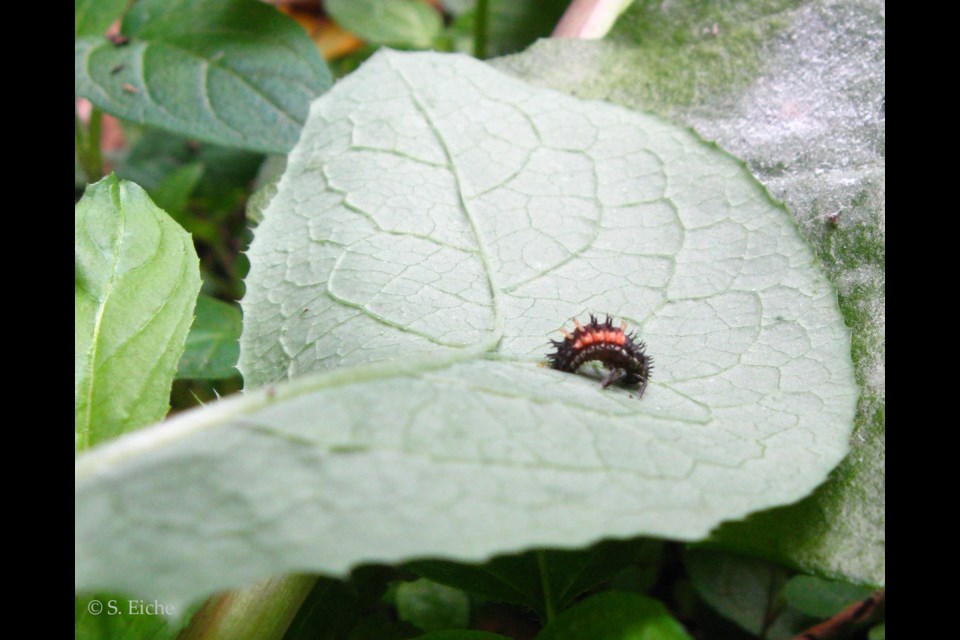What I saw on the lid of my green yard waste bin made me think of an alligator that had shrunk to a quarter of an inch.
I was curious. Why had I never noticed such a strange bug? Did it bite? Was it poisonous? What was it?
I did an online search, typing in a few descriptive terms, and found out that it was the larva of the ladybug.
After seeing the first one, I was spotting them all over the place, mostly on plants and often on the leaves of the big tree in my front yard – a linden, rife with aphids who produce the sticky honeydew and who are a favourite ladybug food.
The most amazing thing was, of course, that the elongated, black and orange creature would soon be turning into – metamorphosing, to use the proper term – an adult ladybug, bearing no resemblance to its former appearance.
The ladybug belongs to the group of insects that undergo complete metamorphosis (more about that below).
Another group, to which a number of familiar culprits belong, go through what is called incomplete or simple metamorphosis.
Silver fish, grasshoppers, mantids and cockroaches are examples of these insects. Their young – called nymphs – look like smaller versions of the adult. While most insects lay eggs, a few, such as the aphid, generate live nymphs.
Complete metamorphosis involves four stages – egg, larva, pupa and adult. Each stage is different in appearance.
Some of the insects belonging to this group that we regularly see around here are the bee, butterfly, chafer beetle, fly and ladybug.
As soon as I’d identified the strange creature that looked like a miniature alligator, I wanted to spy on the ladybug and see with my own eyes its progression from the start to the final "unveiling."
It all began, of course, with two ladybugs mating, which I unashamedly watched and photographed one year in late May.
How long before the female lays eggs? I read it can be any time between one week and a couple of months.
The eggs will be deposited in a protected place, often the underside of a leaf.
One year, I had lots of dill in the garden, and consequently lots of aphids.
To my delight, a ladybug took advantage of the plentiful food situation and laid a dozen bright yellow eggs in a neat row on the underside of a dill leaf – quite a feat, considering the narrowness of dill leaves. I checked the leaf every day, morning and evening.
Seven days later, the eggs hatched. The sight of tiny, black larvae emerging and swarming over the now-empty eggs was riveting.
When food – soft-bodied creatures such as aphids or mites – is readily available, the larva grows quickly.
Within a couple of weeks, it can be as long as that quarter-inch "alligator" that sparked my interest in the ladybug’s metamorphosis.
To reach this size, the larva will have molted several times, shedding its old exoskeleton, or cuticle, and absorbing water to expand its body and stretch its new cuticle.
The next phase is the pupal stage. I’ve observed how the larva bends backwards in a crescent shape to attach itself firmly to whatever surface it’s on.
The surface of choice is usually a green leaf, though I’ve seen ladybug pupae on my green yard waste bin and even on the label of a glass jar.
Inside an orange and black protective cocoon, the insect transforms from larva to adult. It does not move.
It feeds on the nutrients that it has stored in its body from the larval stage. After about a week, the adult ladybug emerges. Its exoskeleton is still soft and pale yellow in colour.
It will take a few hours for the shell to harden and change colour and for the spots to appear.
At the same time, the newly emerged ladybug will be testing its wings, which will need to dry before it can fly off.
And not long after that, the miraculous cycle will begin again.
Sabine Eiche is a local writer and art historian with a PhD from Princeton University. Her passions are writing for children and protecting nature. Her columns deal with a broad range of topics and often include etymology in order to shed extra light on the subject.
📣 Got an opinion on this story or any others in Richmond? Send us a letter or email your thoughts or story tips to [email protected].
📲 To stay updated on Richmond news, sign up for our daily headline newsletter.
💬 Words missing in article? Your adblocker might be preventing hyperlinked text from appearing.

.jpg;w=120;h=80;mode=crop)

